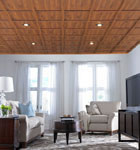A lustrous wood ceiling that’s environmentally friendly and inexpensive? Unlikely. But despite skepticism, there is some evidence: Sauder Woodworking’s attempts to bringing that pipe dream to life, through its new WoodTrac ceiling products. Available in oak and alder, WoodTrac is designed to offer warmth and richness without the expensive bite.
After producing furniture for years, Dan Sauder, vice president of engineering and new markets, says the company wanted to branch out. “We did a brainstorming event,” he says, “and out of that came the idea for a wood-look replacement for suspended ceilings.” Sauder partnered on an “ideation” event with the consulting team at MAGNET, an organization that works with Ohio-area businesses to identify and implement productivity improvements and product innovations. The WoodTrac concept “really fits one of our core capabilities,” Sauder says.
Most ceilings already on the market “were plywood or solid wood,” Sauder says. His team didn’t see anyone doing laminate in a suspended ceiling, and Sauder says they realized they could produce a truly beautiful product at a much better price point than the nearest competitor. The detailing and realism of WoodTrac’s look is helped by high-fidelity paper laminates from Toppan Interamerica, which works on producing sharper and more pleasing grains and colors for Sauder Woodworking to glue on to its medium-density fiberboard (MDF).
Installation is a breeze, Sauder says, with moldings that snap into clips. Assuming there’s already a suspended ceiling place, WoodTrac can be installed without a single screw. Sauder believes the low cost and ease of installation add up to a win for customers. “You end up with a great-looking three-dimensional wood ceiling that looks a lot richer than the white ceilings, for a lot lower cost than any other wood ceiling.”
But is it good for the environment? Actually yes. Obtained largely from Clarion Industries in nearby Pennsylvania, 95 percent of the MDF used in WoodTrac comes from pre-consumer recycled wood waste, so no trees were cut down to make the boards. And Clarion’s proximity to Sauder’s manufacturing operations helps minimize the environmental impact of shipping. “They’re the closest supplier to us for MDF,” Sauder says, “and that’s very appealing to us.”
 Sustainability is nothing new to this nearly 80-year-old company. “We have our own power plant,” Sauder says, “and we make electricity out of our waste. We haven’t had to landfill any wood waste for almost 10 years.” That power plant meets about a third of the company’s electrical needs, while other efforts—the recent installation of an Ecogate dust-collection system and the replacement of more than 6,000 lights throughout the factory and warehouse—also contribute to lower energy costs.
Sustainability is nothing new to this nearly 80-year-old company. “We have our own power plant,” Sauder says, “and we make electricity out of our waste. We haven’t had to landfill any wood waste for almost 10 years.” That power plant meets about a third of the company’s electrical needs, while other efforts—the recent installation of an Ecogate dust-collection system and the replacement of more than 6,000 lights throughout the factory and warehouse—also contribute to lower energy costs.
Recycling and the more efficient use of materials are also priorities, and the total result is astounding. “We end up recycling 96 percent of solid waste in one way or another,” Sauder says, noting that over the past several years, the company also has been monitoring its carbon footprint. “In 2008–2010, we reduced our carbon footprint by 32 percent. That’s through more recycling, our dust-collection improvements, the lighting project, and our other efforts.”
Sauder also is committed to reducing waste in the manufacturing process itself. “We’re doing another million-dollar project to change how we cut our boards,” Sauder says. By using raw materials more efficiently and improving the yield by just several percent, the investment pays for itself. “Those are the kind of things you can do to be environmentally friendly and almost always get a return at the same time,” he says.
The furniture industry has become much more conscious of the environment in the time his family’s company has been around, Sauder explains. Processes and materials have evolved, and Sauder points to reduced use of formaldehyde as an example. “It’s a dramatic change from 20 years ago,” he says; the stink that used to permeate the warehouse—and homes, as new materials off-gassed—is gone.
“It’s taken time to get there, because taking the formaldehyde out makes it harder to produce the MDF while still getting the material to hold its physical properties,” Sauder says. Through innovation and determination, however, Sauder says the industry has made tremendous strides. “We’re down very close to ambient formaldehyde levels,” he adds. What’s possible in the future as companies like Sauder Woodworking continue to innovate is hard to say. But it’s sure to be better for the environment, just like WoodTrac.

